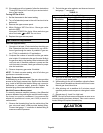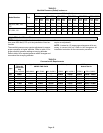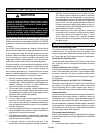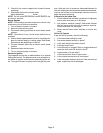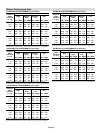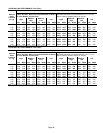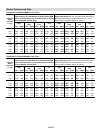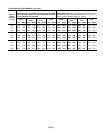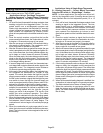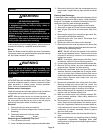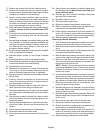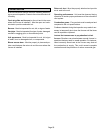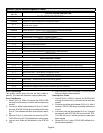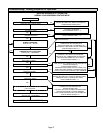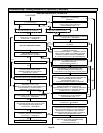
Page 52
Heating Sequence of Operation
NOTE − The thermostat selection DIP switch on the control
board is factory−set in the TWO−STAGE" position.
Applications Using a Two−Stage Thermostat
A − Heating Sequence −− Control Board Thermostat
Selection DIP switch in Two−Stage" Position (Factory
Setting)
1 − On a call for heat, thermostat first−stage contacts close
sending a signal to the integrated control. The inte-
grated control runs a self-diagnostic program and
checks high temperature limit switches for normally
closed contacts and pressure switches for normally
open contacts.The combustion air inducer is ener-
gized at low speed and the humidifier terminal is ener-
gized.
2 − Once the control receives a signal that the low−fire
pressure switch has closed, the combustion air induc-
er begins a 15−second pre−purge in low speed.
3 − After the pre−purge is complete, a 20−second initial ig-
nitor warm−up period begins. The combustion air in-
ducer continues to operate at low speed.
4 − After the 20−second warm−up period has ended, the gas
valve is energized on low fire (first stage) and ignition oc-
curs. At the same time, the control module sends a sig-
nal to begin an indoor blower 45−second ON−delay.
When the delay ends, the indoor blower motor is ener-
gized on the low fire heating speed. The furnace will
continue this operation as long as the thermostat has
a first−stage heating demand.
5 − If second−stage heat is required, the thermostat sec-
ond−stage heat contacts close and send a signal to the
integrated control. The integrated control initiates a
30−second second−stage recognition delay.
6 − At the end of the recognition delay, the integrated con-
trol energizes the combustion air inducer at high
speed. The control also checks the high−fire (second
stage) pressure switch to make sure it is closed. Once
the the control receives a signal that the high−fire pres-
sure switch is close, the high−fire (second stage) gas
valve is energized and the indoor blower motor is en-
ergized for operation at the high−fire heating speed.
7 − When the demand for high−fire (second stage) heat is
satisfied, the combustion air inducer is switched to the
low−fire heating speed and the high−fire (second
stage) gas valve is de−energized. The low−fire (first
stage) gas valve continues operation. The indoor
blower motor is switched to the low−fire heating speed.
8 − When the thermostat demand for low−fire (first stage)
heat is satisfied, the gas valve is de−energized and the
field−selected indoor blower off delay begins. The
combustion air inducer begins a 5−second post−purge
period.
9 − When the combustion air post−purge period is com-
plete, the inducer and humidifier terminal are de−ener-
gized. The indoor blower is de−energized at the end of
the off delay.
Applications Using A Single−Stage Thermostat
B − Heating Sequence −− Control Board Thermostat
Selection DIP switch in Single−Stage" Position
NOTE − In these applications, two−stage heat will be initi-
ated by the integrated control if heating demand has not
been satisfied after the field adjustable period (10 or 15
minutes).
1 − On a call for heat, thermostat first−stage contacts close
sending a signal to the integrated control. The inte-
grated control runs a self-diagnostic program and
checks high temperature limit switches for normally
closed contacts and pressure switches for normally
open contacts.The combustion air inducer is ener-
gized at low speed and the humidifier terminal is ener-
gized.
2 − Once the control receives a signal that the low−fire
pressure switch has closed, the combustion air induc-
er begins a 15−second pre−purge in low speed.
3 − After the pre−purge is complete, a 20−second initial ig-
nitor warm−up period begins. The combustion air in-
ducer continues to operate at low speed.
4 − After the 20−second warm−up period has ended, the gas
valve is energized on low fire (first stage) and ignition oc-
curs. At the same time, the control module sends a sig-
nal to begin an indoor blower 45−second ON−delay.
When the delay ends, the indoor blower motor is ener-
gized on the low−fire heating speed. The integrated
control also initiates a second−stage on delay (factory−
set at 10 minutes; adjustable to 15 minutes).
5 − If the heating demand continues beyond the second−
stage on delay, the integrated control energizes the
combustion air inducer at high speed. The control also
checks the high−fire (second stage) pressure switch to
make sure it is closed. Once the control receives a sig-
nal the high−fire pressure switch is closed, the high−fire
(second stage) gas valve is energized and the indoor
blower motor is energized for operation at the high−fire
heating speed.
6 − When the thermostat heating demand is satisfied, the-
combustion air inducer begins a 5−second post−purge.
The field−selected indoor blower off delay begins.
7 − When the combustion air post−purge period is com-
plete, the inducer and humidifier terminal are de−ener-
gized. The indoor blower is de−energized at the end of
the off delay.



